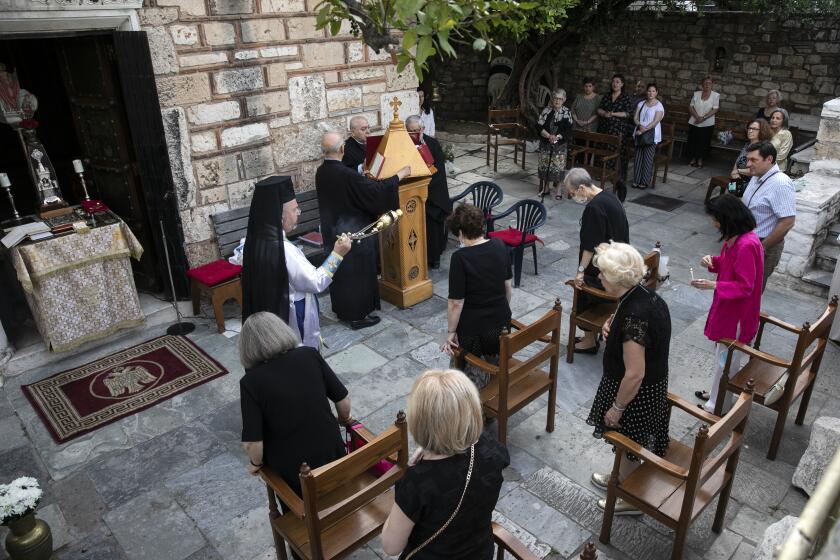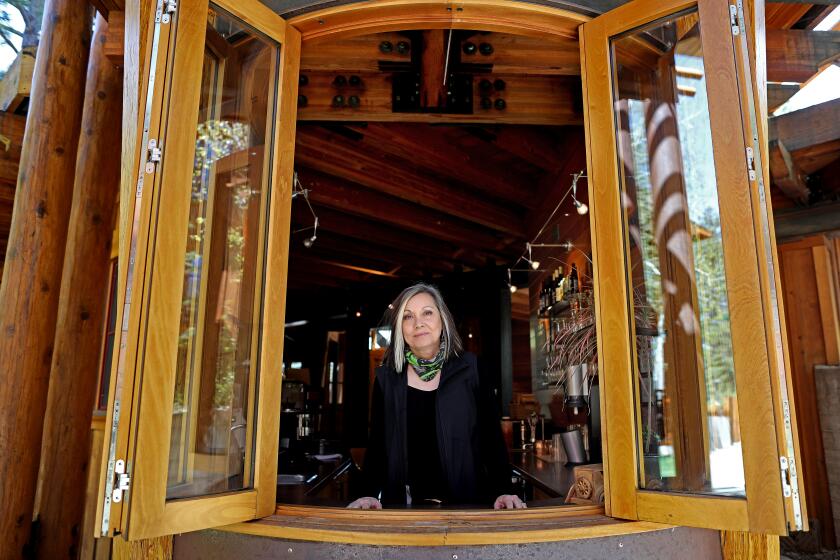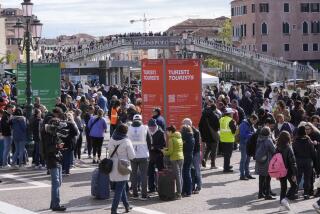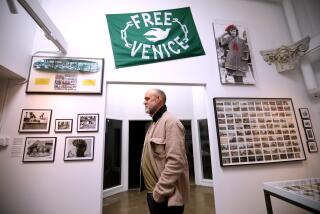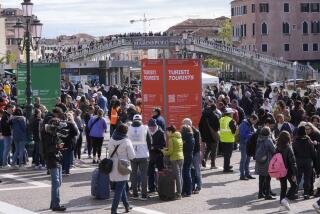European hot spots like Venice, Italy, are reopening, but without many tourists
- Share via
VENICE, Italy — The cafes lining Venice’s Piazza San Marco were closed, their chairs stacked and roped off instead of accommodating guests sipping Aperol spritzes on Monday afternoon, though officially Venice was open for business.
“Those are bars for tourists,” said Anna Dal Bello, a 21-year-old university student who was smoking a cigarette with a friend on the steps of the piazza. “Venetians know where to go to spend less money.”
Dal Bello, who lives in nearby Padua, said she had never seen Venice so quiet.
“It’s always full, even at night,” she said. “We’re enjoying it now.”
Although Venice, Italy, was among the areas in Europe and elsewhere that reopened Monday from their coronavirus-related lockdowns, many would-be tourists facing domestic and international travel restrictions could not show up. Only visitors who, like Dal Bello, live in the Veneto region were able to go.
The city of 55,000 residents, which on some days attracts as many as 60,000 tourists, looked much as it had during the lockdown that began in March.
Stalls along the Rialto Bridge that normally sell everything from leather bags to jewelry to soccer shirts were still locked tight, and museums and galleries that were technically allowed to open opted not to welcome visitors just yet. Some people wearing protective masks strolled along the waterfront and lined up outside gelato shops.
Venice is expected to suffer tremendous losses tied to tourism as the $700-billion global travel industry takes an estimated $250-billion hit this year because of the COVID-19 pandemic, according to the World Economic Forum. Tourism accounts for about 10% of GDP in Europe, which is projected to lose about $75 billion as a result of the global health crisis.
Italy has been among the countries worst hit by COVID-19, with more than 32,000 deaths and more than 225,000 people infected as of Monday.
The circumstances mean cities such as Venice, whose local economies revolve around tourism, must find new ways of doing business. Some residents hope the tourism slump will also provide an impetus to solve long-standing problems such as depopulation and environmental degradation due to mass tourism.
“Everything that has been done in the last 20 or 30 years was for tourism,” said Luciano Gambaro, president of a Murano glass consortium called Consorzio Promovetro Murano. “If that stops, everything stops. It’s been a big mistake.”
Murano, a small island about two miles by boat from the rest of Venice, has been famous for glass blowing since the late 1200s, when Venice’s furnaces were all moved there as a safety precaution against the threat of fires. The current economic situation is extremely difficult, Gambaro said, especially for companies that work in the local industrial supply chain instead of exporting products to foreign customers. It’s unclear yet which of the 150 companies that make up the Murano glass industry will survive.
In separate warnings, two European leaders tell their citizens the world needs to adapt to living with the coronavirus and cannot wait for a vaccine.
The crisis is also creating an opportunity for the people who live and work in Venice to improve the quality of their products, strengthen their brands and serve the local population instead of just tourists, Gambaro said.
“Before, there were certain things that people didn’t want to hear,” he said. “Now that everything is stopped, things need to be rethought. It doesn’t make sense to throw away 1,000 years of history.”
At Gambaro & Tagliapietra Glass Studio on Murano on Monday, glassblower Matteo Tagliapietra sat on a rough wooden bench and breathed into a long metal tube with a molten ball of clear glass fused to the end.
Tagliapietra, 46, gently rolled the glass back and forth on the ground as the insides began to hollow into the shape of a cup, then stood up and carried the tube a few feet over to a furnace burning at more than 2,100 degrees. He plunged the glass inside the furnace and chatted with a colleague as electric orange flames escaped through seams in the front of the kiln.
Work at the studio had mostly returned to normal, he said.
But the Murano glass industry was facing difficulties even before the coronavirus hit. Mass tourism has caused a long-term housing shortage in Venice, which in turn has led to the historic city center and smaller islands losing half their residents since 1966. In late April, the city signed a protocol with a local property association to convert empty short-term tourism rentals into longer-term student housing.
The protocol “aims to encourage residency in the municipality of Venice,” Mayor Luigi Brugnaro said in a statement at the time. “This moment of medical emergency has demonstrated the need to overcome the city’s usual rental schemes.”
For the time being the city has also halted the arrival of cruise ships, which normally bring about half of Venice’s daily visitors but cause significant environmental damage to the surrounding lagoon. Residents such as environmental scientist and activist Jane da Mosto, director of the nonprofit We are Here Venice, hope that smaller, more sustainable boats will be more prevalent even after the pandemic is over.
“There’s a huge potential for traditional rowing to be part of everyday life, and not as in going back to the past but actually in looking toward the future,” Da Mosto said.
During the pandemic, out-of-work gondoliers quickly offered to deliver groceries to older Venetians for whom it wasn’t safe to leave the house, which also helped reduce the amount of foot traffic on the city’s narrow streets. The prevalence of manually powered boats helped improve air and water quality, and also regulated water traffic by keeping motorboat speeds lower.
Tourist spots prepare to welcome visitors once coronavirus restrictions are lifted
In the future, rowers could continue making food deliveries to encourage local consumption, or they could do things like pick up kids from extracurricular activities while their parents are at work. The city could hold workshops and surveys to better understand residents’ skills and knowledge, Da Mosto said.
She acknowledged that the economics are not as straightforward as tourism, but analysts don’t expect tourism to fully recover in Italy until 2023. Venice is predicted to be one of the last places to which travelers return, because social distancing measures are so difficult in the city’s winding streets and narrow alleyways.
“Nothing is going to bounce back,” Da Mosto said. “We can’t change what happened, but if we’re patient, we can consider long-term options.”
And that, she said, would make Venice nicer to live in and to visit.
Brancolini is a special correspondent.
More to Read
Sign up for Essential California
The most important California stories and recommendations in your inbox every morning.
You may occasionally receive promotional content from the Los Angeles Times.
